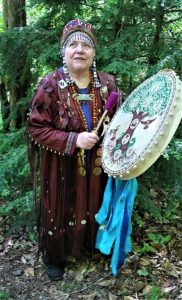
In every culture practicing shamanism, the practitioner accumulates, whether by purchasing, making or inheriting, ritual tools and garb, the function of which are to enhance his or her power and effectiveness. We don’t know what our Northern Tradition Ancestral shamans would have worn, but we can take our cues from the Mongolian, Trans-Siberian and Saami cultures who are our cousins and who have managed to maintain intact cultural practices.
Although the construction and materials may vary significantly from one tradition or tribe to another, shamans’ coats have in common their function: to act as both energetic batteries for the shaman to draw upon and as spiritual armor to protect the practitioner from harmful energies and spirits. In Mongolia, most shamans’ coats are cut in the style of the Deel, a loose garment with overlapping front panels, most often made of heavy silk brocade. Given that silk is an excellent insulator, this makes perfect sense. As one moves northward, the nomadic reindeer herders are more likely to use leather and fur. Not only are these materials warmer, they are also more readily available. Regardless of the foundation material, these ritual garments all seem to be adorned with a collection of objects having significance for the wearer and can be extremely heavy.
Historically, shamans’ coats were made by specific shamans who specialized in their creation, with the recipient adding talismans, charms, and power objects over time. Other shamans, referred to as white smiths (in contrast to blacksmiths) specialize in the making of such talismans and the bells and tiny tools and weapons often added to the coats. These specialized crafts have pretty much died out and it is common for the family of the candidate to ‘commission’ the coat to be sewn by particular seamstresses according to directions given in dreams, through divination, or as guided by the candidate’s teacher.
In the Northern Tradition, the one I work within, the first three levels of training comprise one’s apprenticeship, with specific tools associated with the attainment of each level. Apprentices may be cleared to practice specific skills, but are required to identify themselves as apprentices. Upon completion of the first three levels and assuming favorable divination, the apprentice undergoes an initiation which vests one with the full heritage of the tradition’s Elders and one’s personal teacher. Once again, there is divination to determine whether the Gods and Spirits accept the outcome of the candidate’s initiation. While one will continue to learn and grow throughout the remainder of one’s life, at this point the candidate is considered a capable of independent practice.
The shaman’s coat is the badge that signifies in the Northern Tradition that one has met these requirements and has given one’s life in service to the Gods and spirits. In a process that took months, I designed and made my own coat, named “Hestr”, the Old Norse word for “Horse”. I meditated and journeyed, asking my Patron Deities and ally spirits what would please them.
Constructed of rusty brown deerskin, Hestr is adorned with dozens of small brass bells, fringes, horsehair tassels, and tons of charms and talismans. It’s strongly enspirited, both through my prayers and intent as I made it and through all the things added to it. With each subsequent time I wear it in ceremony, the energy gets stronger, and the simple act of putting it on now alters my state of consciousness. What began as a ritual garment has become both an “ongon” or “spirit house” and a much loved ally.